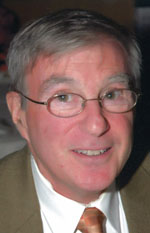“We Are Jews Again,” Jewish Activism in the Soviet Union by Yuli Kosharovsky, translated by Stefani Hoffman, edited by Ann Komaromi, Syracuse University Press, Syracuse, NY, © 2017, ISBN 978-0-8156-3519-2, p. 319, plus appendices, notes, bibliography, and index, $37.95
By Fred Reiss, Ed.D.

WINCHESTER, California – Many Jews participated in the 1917 Russian Revolution, ousting the Tsars and their centuries-old climate of anti-Semitism. A new regime, under Stalin, beginning in 1941, was no better. However, with the birth of the State of Israel came an awakening within Soviet Jewry that an alternative presented itself to the ambient anti-Semitism and repression of Jewish culture. We Are Jews Again is a condensed and redacted version of Yuli Kosharovsky’s four-volume treatise entitled, We Are Jews Again: Reflections on the History of the Zionist Movement From the Soviet Union.
Kosharovsky begins with the immediate post-World War II years through Stalin’s death in 1953, calling this period the “black years of Soviet Jewry,” a period in which Soviet leadership promulgated lies about Jews, and prominent Jews were either murdered or arrested. The official Soviet press, for instance, erroneously reported that Jewish doctors conspired to poison high-ranking Communist Party officials, leading to their arrest, and on August 12, 1952, “thirteen Jewish writers, intellectuals, and artists were shot.”
Through extensive interviews with activists who risked their lives to escape Soviet authoritarianism, we come to learn that two events accelerated their desire to learn Hebrew, become culturally aware of their religion, and emigrate to Israel: the publication in 1958, of Exodus, a retelling of experiences of Holocaust survivors aboard the immigration ship Exodus bound for Palestine in 1947, by Leon Uris, and the stunning victory of the Israelis in the Six-Day War in 1967, over numerous Arab nations using Soviet-supplied weapons.
Though only loosely organized, dozens of activists began meeting soon after in order to maintain solidarity and disseminate information about Israel to other like-minded Jews. Some submitted papers to obtain exit visas, which often led to loss of job and family discord, and in the worst case, trumped-up charges and imprisonment.
Many veteran activists in leadership positions were permitted to leave the Soviet Union in the late 1960s and early 1970s, making way for new leaders who had not experienced Stalin’s cruelty, and thus were less afraid to protest in public; subsequently changing both the context and tactics of the movement. These participants, who openly protested Soviet policies against aliyah, emigration to Israel, became known as “refuseniks.” Luck, according to Kosharovsky, also played a role during this period. First, the Jackson-Vanik Amendment, which linked human rights to preferred-nation status for US trade, and second, détente, beginning with the Nixon-Brezhnev summit in May, 1972, culminating in the Helsinki Accords in 1975, and opening the Iron Curtain to Western scientists, for example, giving the refuseniks an outlet to the free world.
Kosharovsky notes that unanimity among the various groups did not prevail. In particular, one group fought for rights within the Soviet Union, while others outright rejected living there, demanding the right to leave. Whatever their position, the KGB made life miserable, and Kosharovsky’s interviews show the difficulties faced by activists’ families as they struggled to survive.
In late 1979, the Soviet Union unexpectedly invaded Afghanistan, shocking the West, as Carter and Brezhnev had signed the SALT-2 Agreement just a few months earlier. “The achievement in détente of the past few years were wiped out in a moment and the Iron Curtain again descended on the borders of the Soviet bloc,” writes Kosharovsky. The growing number of exit visas, which had grown in number during the 1970s, came to a crashing halt, along with a resurgence of harsh repressive policies enforced by the KGB through “numerous threats, interrogations, searches, and arrests of activists.”
Despite these oppressive actions, Kosharovsky reports that Jews still participated in scientific and cultural seminars with foreign guests, and attended Ulpan classes to learn Hebrew. He describes his personal involvement in Mashka, from the Hebrew word for “club,” the getting together of like-minded Jews who clandestinely met with foreigners in various apartment.
Another fortuitous act for the refuseniks came with the death of Konstantin Chernenko, the last of the “Kremlin elders,” who died in March, 1985, resulting in the ascension of Gorbachev and his policy of perestroika, and to the early release from prison of such notable dissenters as Sharansky and Sakharov. By 1987, Kosharovsky tells us, perestroika began to positively affect the refuseniks, such as “an official reception at the American ambassador’s residence… for Jewish activists, dissidents, and religious figures,” and within two years, a large number of Jewish activists from fifteen cities met and founded a Zionist organization, Irgun Tzioni.
Although the overwhelming majority of “veteran” Jewish activists left the country during this period, new objectors appeared and continued the struggle. In 1990, more than half-million Soviet Jews received invitations from Israel, and over a quarter of a million of them left the Soviet Union, with more than eighty percent going directly to Israel.
Kosharovsky concludes that even “in the face of persecution, searches, interrogations, arrests, exile, forced psychiatric treatment, or difficult army service…. The Jewish people found their inner resources to unite for this struggle, and from this unequal battle they emerged victorious.”
We Are Jews Again is a concise, yet authoritative, first-person description of the six-decade struggle of Soviet Jewry against a harsh and unforgiving government for their right to emigrate to Israel. His interviews, which he relates verbatim, concretize the hellish reality faced by all who opposed the Soviet hierarchy. It is a must reading for anyone interested in modern Jewish or Soviet history.
*
Dr. Fred Reiss is a retired public and Hebrew school teacher and administrator. His newest book is The Jewish Calendar: History and Inner Workings. The author may be contacted via fred.reiss@sdjewishworld.com.